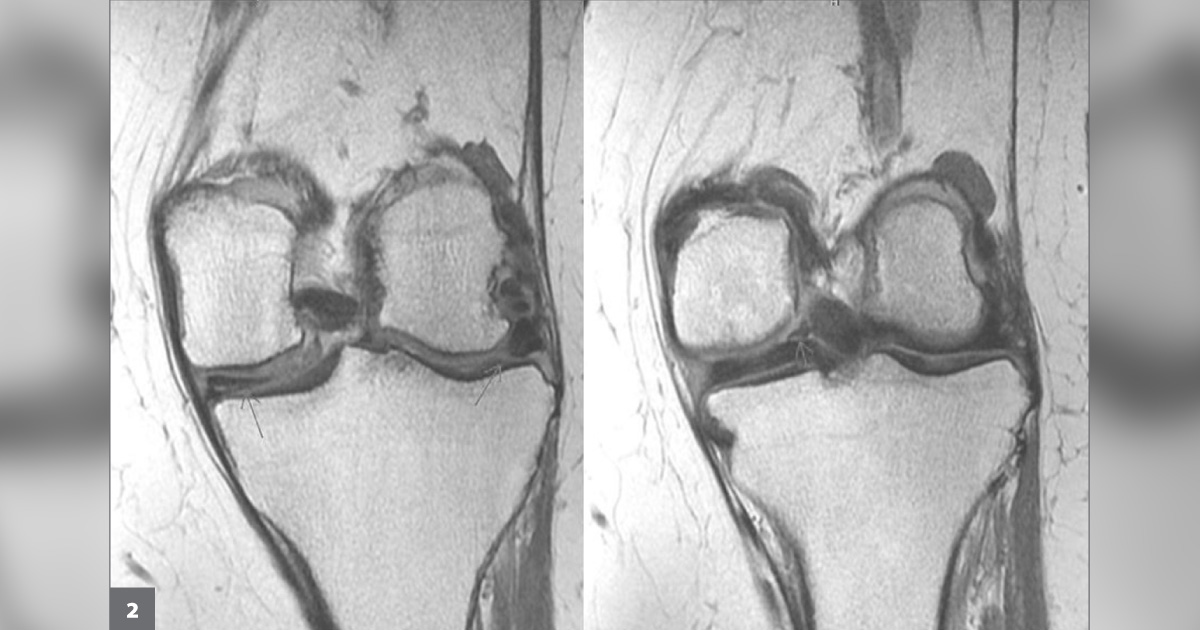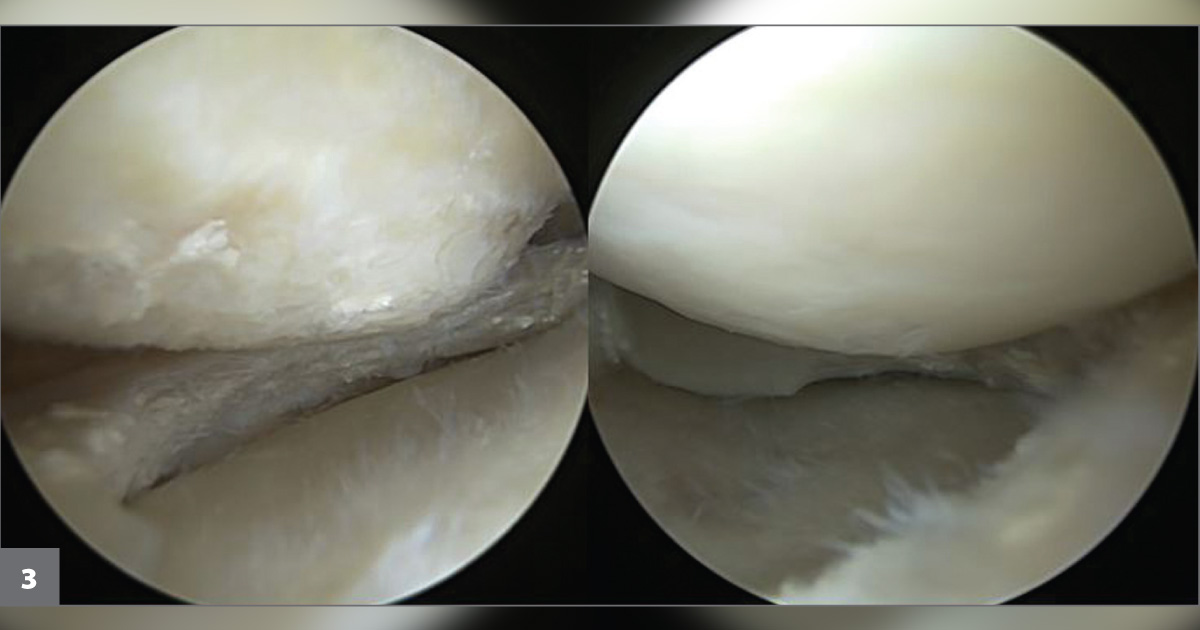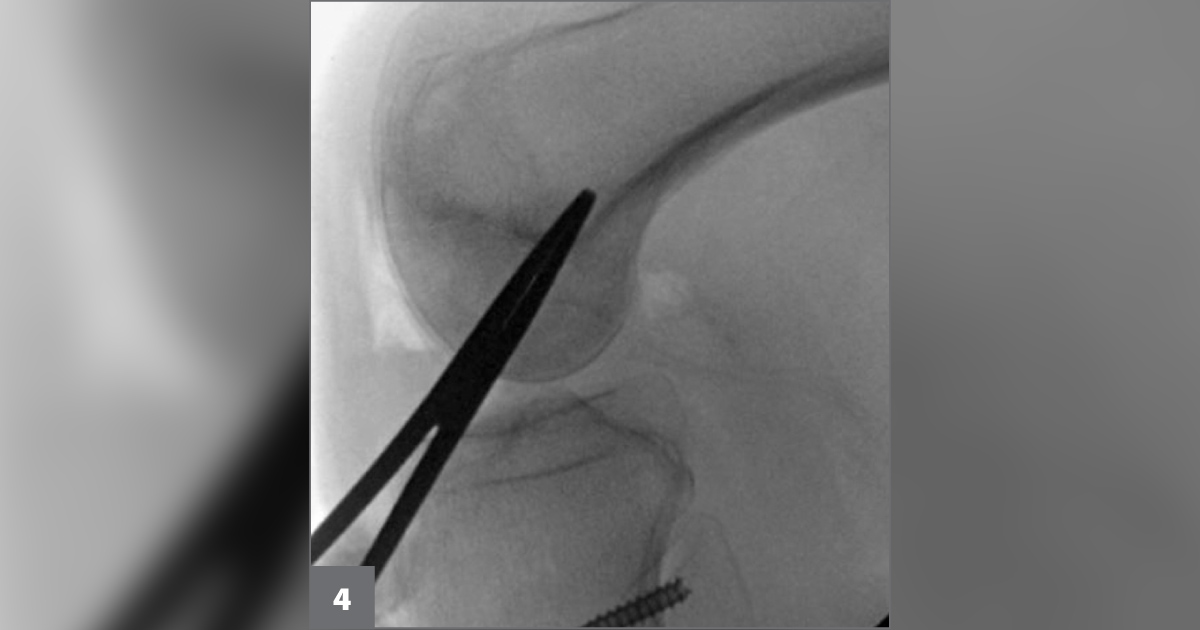A 71-year-old woman with extensor mechanism instability after prior patellectomy
A 71-year-old woman sustained a fall onto her anterior left knee. Following this, she reports having 10 months of subjective instability during activities of daily living before seeking orthopedic evaluation.


The patient denied having any significant associated pain, but she had apprehension with knee flexion and extension. Of note, the patient had prior bilateral patellectomies for patellofemoral pain at age 15 years and, more than 15 years prior to her current presentation, she underwent contralateral total knee arthroplasty. She was in otherwise good health, ambulating and living independently.

Source: Jay H. Patel, MD
Examination of the left knee was notable for 0° to 110° range of motion, which was similar to the contralateral limb. However, at 30° flexion the extensor mechanism was felt to consistently dislocate laterally over the trochlea. This was painless, but reproducible during the flexion-extension cycle. She had no effusion, no laxity to varus and valgus stress and was neurovascularly intact. Plain films showed a reduced left knee with mild arthritic changes in the setting of prior patellectomy (Figure 1). A course of physical therapy was initiated. An MRI was ordered to evaluate the cartilage surfaces and measure the tibial tubercle-trochlear groove (TT-TG) distance. This demonstrated some degenerative tearing of medial and lateral menisci (Figure 2), mild chondromalacia in the medial and lateral compartments and a TT-TG of 22 mm. Ultimately, physical therapy did not improve her symptoms. The patient returned desiring surgical intervention for her ongoing problem.

What are the treatment options?
See answer below.
Arthroscopy, TT osteotomy and medial quadriceps tendon-femoral ligament reconstruction
Patellar instability and extensor mechanism subluxation are a common issue encountered by orthopedic surgeons. However, extensor mechanism subluxation in the setting of prior patellectomy is not routinely seen. Patellar instability can be successfully treated by a myriad of options, including physical physical therapy and surgical techniques depending on patient anatomy.
Surgical treatment is often indicated for recurrent patellofemoral instability. However, the surgical decision-making process is often multifactorial and surgeon dependent. Operative management involving medial patellofemoral ligament (MPFL) reconstruction, TT osteotomy and/or extensor mechanism realignment are most common. There are also a variety of other techniques that have been used in the pediatric population to avoid physeal injury.
Surgical considerations
Many factors should be considered when discussing treatment options with this patient. She is 71 years old with symptomatic patellar instability of the left knee, mild arthritic change and an elevated TT-TG distance of greater than 20 mm. Continuing nonoperative management with extended physical therapy would be unlikely to resolve her symptoms. Surgical management could include a soft tissue procedure, such as an MPFL reconstruction; however, she has no patella, and this procedure would still not address her underlying elevated TT-TG. An osseous procedure, such as a TT osteotomy could address her anatomical issues, but there is concern for bony healing potential in an older, low-demand woman. Furthermore, although she does not have pain at this time and only symptoms of instability, consideration should be given to the possibility that she may require TKA in her lifetime. Taking all these factors into consideration, it was ultimately felt her best surgical option would be left knee arthroscopy, TT osteotomy and medial quadriceps tendon-femoral ligament reconstruction (MQTFL), which has previously been described by John P. Fulkerson, MD. This reconstruction allows stabilization of the laterally unstable extensor mechanism without patellar fixation.
Operative technique
The patient was placed in the supine position on the standard operating table. An arthroscopic leg holder was used for additional positioning. A tourniquet was used for hemostasis and visualization. An open anterior surgical approach was performed. Through this incision, anteromedial, superomedial and anterolateral primary portals were placed. Both medial and lateral compartments had partial meniscectomies and chondral debridements performed (Figure 3). The amount of degenerative change overall in the knee was confirmed to be mild enough to continue with all additional procedures.

Allograft reconstruction
After the arthroscopic portion of the procedure, the MPFL remnant was identified and noted to be completely deficient. The TT was then predrilled for subsequent fixation with two screws. An angled and lateral to medial cut was made behind the TT using the oscillating saw and osteotome. The anterior TT was elevated 5 mm. The achieved medial displacement of the TT was 10 mm. Stabilization was accomplished with two cannulated metal interference screws with washers. The MQTFL was reconstructed with a semitendinosus allograft secured extra-articularly using suture and screw fixation. The MQTFL was reconstructed using Schottle’s point on the distal femur (Figure 4). This semitendinosus graft was secured at this point using a 6.5-mm biocomposite screw. The quadriceps fixation technique used differed from that of Fulkerson and colleagues and Sheeba M. Joseph, MD, and colleagues in that we split that graft into two limbs to secure into the quadriceps. Each limb was then passed under the quadriceps tendon using a medial split, brought anteriorly again via a lateral split in the quadriceps tendon and then sutured over the top to itself (Figure 5).

The patient’s postoperative course included protection in a knee immobilizer for 3 weeks with advancement of range of motion with therapy. After 6 weeks, her range of motion was 0° to 100° and improving. She had no extensor mechanism subluxation throughout the flexion-extension cycle and endorsed no apprehension. She had no pain and, importantly, she had no complaints of knee instability postoperatively.

Discussion
Patellar instability can be a difficult problem to treat. There is no set algorithm that applies to all patients. Conservative treatment does have a role in a first-time dislocation, but surgical intervention is preferred in cases of repetitive extensor mechanism dislocation or subluxation. MPFL reconstruction with a possible addition of a TT osteotomy is commonly performed. Extensor subluxation becomes a more difficult problem when there is no patella, such as in our patient.
MQTFL is an option for soft tissue stabilization of the extensor mechanism. This technique avoids any fixation involving the patella, decreasing the risk of secondary patella fractures. Although patellectomy for patellofemoral pain syndrome has fallen out of favor, the MQTFL technique can also serve as a useful alternative in the setting of prior patellectomy. This situation has also been previously reported by Laurie A. Hiemstra, MD, PhD, FRCSC, and colleagues with good postoperative subjective and objective outcomes. Although it is early in the postoperative period, we are pleased with the result we have obtained and recommend consideration of this technique when a clinician encounters the situation of extensor mechanism instability with an inability to provide fixation to the patella.
- References:
- Diduch DR, et al. J Am Acad Orthop Surg. 2018;doi:10.5435/JAAOS-D-16-00052.
- Fulkerson JP, et al. Arthrosc Tech. 2013;doi:10.1016/j.eats.2013.01.002.
- Hiemstra LA, et al. J Am Acad Orthop Surg Glob Res Rev. 2017;doi:10.5435/JAAOSGlobal-D-17-00001.
- Joseph SM, et al. Arthrosc Tech. 2018;doi:10.1016/j.eats.2018.09.002.
- Longo UG, et al. Arthroscopy. 2016;doi:10.1016/j.arthro.2015.10.019.
- Redler LH, et al. J Am Acad Orthop Surg. 2018;doi:10.5435/JAAOS-D-17-00255.
- For more information:
- Joel Boyd, MD, is an attending surgeon; Travis L. Frantz, is a sports medicine and shoulder fellow; and Jay H. Patel, MD, is a sports medicine and shoulder fellow at TRIA Orthopaedic Center. They can be reached at 8100 Northland Drive, Bloomington, MN 55431. Boyd’s email: joel.boyd@tria.com. Frantz’s email: travis.frantz@tria.com. Patel’s email: jay.patel@tria.com.
- Edited by Travis Frantz, MD, and Ian Savage-Elliott, MD. Frantz is a sports medicine and shoulder fellow at TRIA Orthopaedic Center in Minneapolis. He completed his orthopedic surgery residency at The Ohio State University Wexner Medical Center in Columbus, Ohio. Savage-Elliott is a chief resident in the department of orthopedic surgery at Tulane University Medical Center in New Orleans. He will pursue fellowship training in foot and ankle and sports medicine following residency completion. For information on submitting Orthopedics Today Grand Rounds cases, please email: orthopedics@healio.com.
